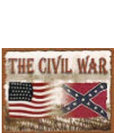|
 The Maryland Campaign of 1862 & Battlefield Map - Sharpsburg, MD
N 39° 28.452 W 077° 44.717
18S E 263858 N 4372999
The mother of all Antietam interpretives can be found near the parking lot at the Battlefield visitor center. It also has a friend next to it, which details all the monuments and markers on the battlefield.
Waymark Code: WMDGFP
Location: Maryland, United States
Date Posted: 01/12/2012
Views: 7

There are two side-by-side, vertically held markers at the visitor center. The one on the left (this marker) tells all about the Civil War and when it came to Maryland. The one on the right is even more interesting; it deciphers the monuments, memorials, markers and anything else interesting at the battlefield. There is an order and purpose to all the monuments, tablet and structures located here. The other marker is also an orientation table of sorts and provides information about the battlefield and suggestions for tours.
The marker was erected in 2009 by the Antietam National Battlefield - National Park Service - Department of the Interior. The sign and visitor center are on Dunker Church Road. The marker reads:
"...we are driven to protect our own country by transferring the seat of war to that of an enemy who pursues us with a relentless and apparently aimless hostility."
President Jefferson Davis
September 7, 1862
"The present seems to be the most propitious time since the commencement of the war for the Confederate army to enter Maryland."
General R.E. Lee
September 2, 1862
"God bless you and all with you. Destroy the rebel army if possible."
President Abraham Lincoln
September 15, 1862
"...if we defeat the army arrayed before us, the rebellion is crushed, for I do not believe they can organize another army. But if we should be so unfortunate as to meet with defeat, our country is at their mercy."
Maj. Gen. George B. McClellan
September 11, 1862
"...exposed to the fire of slavery and freedom"
That is how Pvt. Julius Rabardy described the chaos at Antietam as he lay on the battlefield, caught between the lines, his leg shattered by the musketry of both armies.
The Battle of Antietam was the culmination of the Maryland Campaign of 1862, the first invasion of the North by Confederate General Robert E. Lee and the Army of Northern Virginia. Southern armies were also advancing in Kentucky and Missouri as the tide of war flowed north. After Lee's dramatic victory at the Second Battle of Manassas during the last two days of August, he wrote to Confederate President Jefferson Davis that "we cannot afford to be idle." Lee wanted to keep the offensive and secure Southern independence through victory in the North; influence the fall mid-term elections; obtain much needed supplies; move the war out of Virginia, possibly into Pennsylvania; and to liberate Maryland, a Union state, but a slave-holding border state divided in its sympathies.
After splashing across the Potomac River and arriving in Frederick, Maryland, Lee boldly divided his army to capture the Union garrison at Harpers Ferry, Virginia (now West Virginia). The 12,000 Union soldiers there threatened Lee's vital link south. Gen. Thomas "Stonewall" Jackson and about half of the army were sent to capture the Union garrison. The rest of the Confederates moved north and west toward South Mountain and Hagerstown, Maryland.
In Washington, D.C., President Abraham Lincoln turned to Major General George B. McClellan to protect the capital and respond to the invasion. McClellan quickly reorganized the demoralized Army of the Potomac and advanced toward Lee. The armies first clashed on South Mountain where on September 14 the Confederates tried unsuccessfully to block the Federals at three mountain passes - Turners, Fox, and Crampton Gaps. Following the Confederate retreat from South Mountain, Lee considered returning to Virginia. However, with word of Jackson's capture of Harpers Ferry on September 15, Lee decided to make a stand at Sharpsburg.
The twelve hour battle began at dawn on September 17. Savage, incomparable combat raged across the Cornfield, East Woods, West Woods, the Sunken Road, and Burnside Bridge as Lee shifted his men to withstand each of the Union thrusts. Despite more than 23,000 casualties of the nearly 100,000 engaged, both armies stubbornly held their ground as the sun set on the devastated landscape. The next day, September 18, the opposing armies gathered their wounded and buried their dead. That night Lee's army withdrew back across the Potomac to Virginia, ending Lee's first invasion of the North. Lee's retreat provided President Lincoln the opportunity he had been waiting for to issue the preliminary Emancipation Proclamation. Now the war had a dual purpose of preserving the Union and ending slavery.
Group that erected the marker: Antietam National Battlefield - National Park Service - Department of the Interior

URL of a web site with more information about the history mentioned on the sign: [Web Link]

Address of where the marker is located. Approximate if necessary:
Antietam Battlefield Visitor Center
Dunker Church Road
Sharpsburg, MD USA
21782

|
Visit Instructions:
Take a picture of the marker, preferably including yourself or your GPSr in the photo. A very detailed description of your visit may be substituted for a photo. In any case please provide a description of your visit. A description of only "Visited" or "Saw it while on vacation" by anyone other than the person creating the waymark may be deleted by the waymark owner or the category officers.
Recent Visits/Logs:
| There are no logs for this waymark yet. |
|
|
|
|